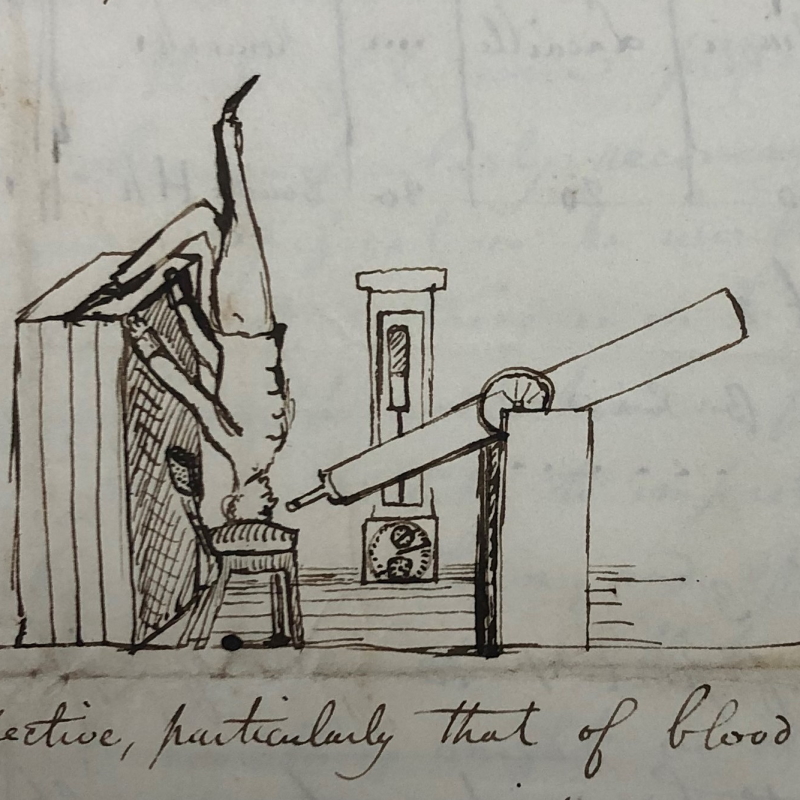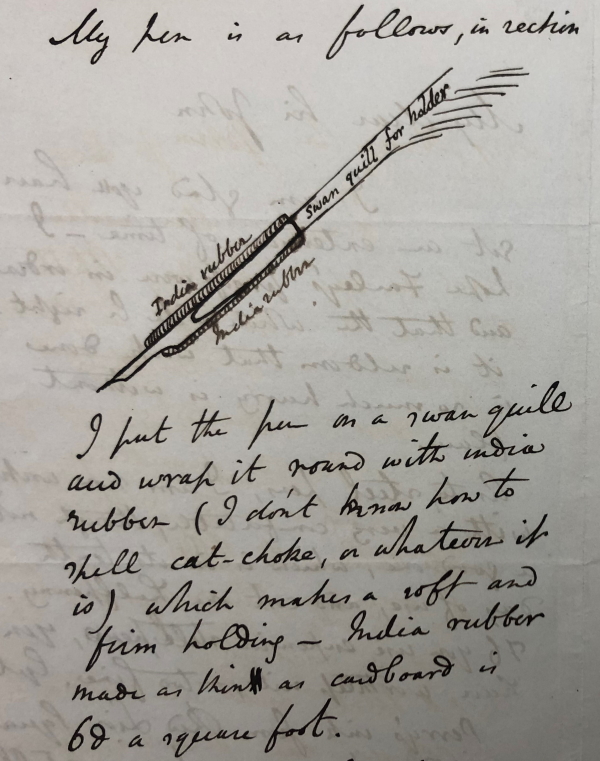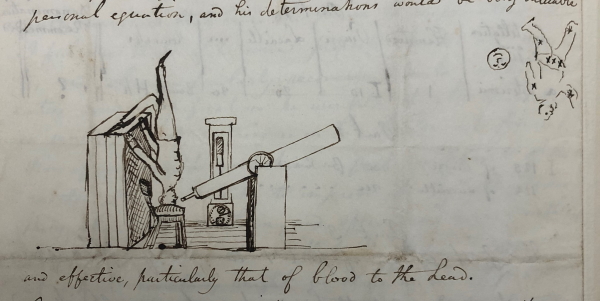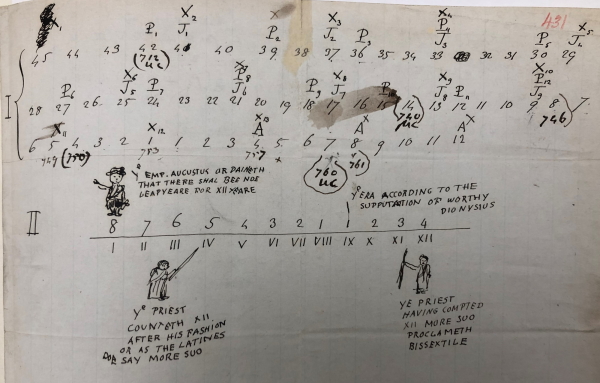Virginia Mills is entertained by the witty letters and cartoons - including a depiction of the Astronomer Royal standing on his head - sent by mathematician Augustus De Morgan to his friend John Herschel.

Augustus De Morgan was a leading mathematician of the nineteenth century and a pioneer of applied logic, but not a Fellow of the Royal Society. So why is he popping up on this blog?
Well, many of De Morgan’s friends were Fellows of the Royal Society, and although he resisted their encouragements to FRS his tail, it’s through one such friend that we come to have a very significant and entertaining collection of De Morgan’s letters in the Royal Society archive. They can be found within the voluminous Herschel Papers, received by the great astronomer and polymath Sir John Herschel FRS from his extensive network of learned correspondents.
There are 250 letters from De Morgan, covering the two men’s shared interests in astronomy and mathematics, but also including some playful exchanges and scientific satire. The earliest manuscripts, dating to 1831, were written in De Morgan’s capacity as Secretary of the Royal Astronomical Society (RAS), requesting papers for their publications. Herschel was an RAS founder, oftentimes Council Member and sometime President – or in De Morgan’s words, one of its ‘wisest heads’.
Though initially formal and administrative, the letters soon begin to display De Morgan’s trademark wit, neat turn of phrase and what Herschel describes as his ‘punning humour’:
‘Why is Sir John Herschel as good as two astronomers?’ De Morgan asks.
Answer: ‘Because he’s a (double-star) gazer = double (star-gazer).’
This refers to Herschel’s re-examination of the double stars discovered by his father William, who had first proved that such binary stars orbit each other. Don’t ask me if he’s balanced that equation of words correctly!
Their letters are peppered with such riddles and in-jokes, often reflecting their current research and the latest contemporary developments in astronomy. In 1841 De Morgan teased Herschel with this rhyme:
One telescope all others must excel
Sir Herschel’s, why, I pray you quickly tell
What better proof of goodness can be given
When even Hell would rather ‘twere in Heaven
In the same year, a telescope-shaped constellation that had been named Telescopium Herschelii by one Maximillian Hell, in honour of William Herschel’s discovery of Uranus in the 1780s, had been left out of Argelander’s most recent celestial maps – removed from the record of the heavens where presumably its satanically-named christener would rather see it restored.
De Morgan turned his pen to illustration as well as wordplay. Some of his drawings are instructive – in fact from this one we can see the construction of De Morgan’s pens themselves, with a comfortable grip made of India rubber:

I don’t have Herschel’s side of the correspondence for confirmation (there are only a few drafts and amanuensis copies of his outgoing letters in our collection), but this could have been sent in response to a genuine query regarding De Morgan’s construction of pens. Equally, I suspect it might have been a sarcastic rejoinder to the question of how he pens such witty letters. The tone of De Morgan’s letters shifts so readily from algebraic functions to wild fancies delivered deadpan that sometimes it can be hard to tell!
Some drawings are more obviously comic and presumably not to be tried at home. This one depicts Herschel and De Morgan’s mutual friend George Biddell Airy, who was at the time no less a figure than the Astronomer Royal, at his telescope… and on his head:

The accompanying letter, sent to Herschel in 1837 whilst he was at the Royal Observatory, Cape of Good Hope in South Africa, claimed that to try and emulate the ‘topsy turvy’ view of Orion which Herschel reported seeing in the southern hemisphere, Airy told De Morgan he intended to ‘stand upon his head the first fine night and look at it’. De Morgan declared that Airy’s determinations would be very valuable and effective, ‘particularly that of blood to the head’.
In these riddles and light-hearted drawings, I see the trademarks of someone with the keen wit and observational skills that must be required to be an astronomer and a master of logic like De Morgan. The same skills, after all, make a good caricaturist – the detail of the cocked leg as the yogi-like Astronomer Royal balances at his instrument brings a dash of reality to the absurd. The Man in the Moon smiling his mocking, upside-down smile may be an added reference to Herschel’s unwanted role in the Great Moon Hoax two years earlier.
De Morgan was also willing to satirise himself and fellow mathematicians, joking, for example, about the inconsistency of dating systems in the cartoon below, ‘part of the prospectus of a new work to be called the fun2y algebra’. De Morgan was interested in the history of mathematics and the modernisation of calendars and other systems such as coinage, and was a strong proponent of decimalisation a century before it was introduced to the UK.

Herschel and De Morgan both died in 1871, having continued to entertain each other by correspondence to the end. Afterwards their wives wrote to each other and made copies of their husband’s exchanges, a role the overlooked wives of great men often played in memorialising their husbands. Such transcribed copies of manuscripts often led to biographies like the one Sophia De Morgan wrote of her husband, as well as other works such as edited editions of letters and the publication of previously unprinted papers.
In one of her letters to Lady Herschel, Sophia De Morgan – herself an accomplished tutor who taught Ada Lovelace – also suggested she might put together a compendium of their husbands’ riddles for publication, though as far as I can tell no such production ever emerged. A project perhaps for someone to take up from Sophia – there are many more riddles to be picked apart by those more versed in astronomy and mathematics than myself, and I hope this blog may pique someone’s interest.
I shall end as De Morgan liked to end his letters – with a riddle. And I’ve borrowed this one from him:
What insult do you offer a person after you tell him that he is not a donkey’s tail?
Why, of course you wish to intimate that he is no end of an ass.

